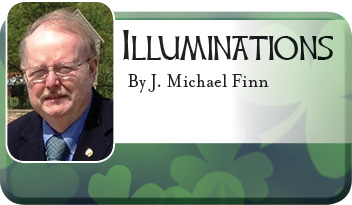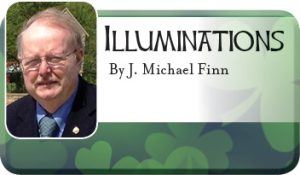

Illuminations: The Whiteboys
By: J. Michael Finn
Historians have noted that one reason for the success of American Revolution was that the British Army was unable to supply sufficient troops to the American colonies to adequately put down the revolution (the British were forced to employ the Hessians, who were German mercenaries). Why were the British so shorthanded?
The reason was they had committed too many troops to Ireland. Ireland was partially responsible for winning the American Revolution.
At the time, there was a lot going on in Ireland to keep the British busy. Between 1735 and 1760, there was an increase of Irish land used for grazing and beef cattle, in part, because pasture land was exempt from tithes (Church of Ireland taxes).
The landlords in Ireland leased their lands to tenant farmers at a rate far above their value. As more landlords and farmers switched to raising cattle, laborers and small tenant farmers were forced off the land.
Since the Irish tenants had no legal rights to the land they leased (known as Fixity of Tenure), the practice of mass eviction was used to vacate the fields for grazing. In order to defend the tenants from eviction, and other abuses, several secret oath-bound societies developed in Ireland.
These were hard times for the small farmers and laborers. Local law was administered by the landlords who, for the most part, had little sympathy for the ordinary people. Nor could they hope for anything better from the higher courts, even if they had the money to seek legal help. It was in this situation that the Whiteboys, claiming to be the champions of the oppressed, emerged from among the peasantry.
Levelers
The Whiteboys, or na Buachaillí Bána in Irish (Pron: na boo-hal-ee bah-na) were a secret Irish agrarian organization in 18th century Ireland who used violent and non-violent tactics to defend tenant farmer land rights. Their name derives from the white smocks that members wore. Because they leveled the fences at night, they were sometimes referred to as “Levelers” by the authorities.

The Whiteboys sought to address exorbitant rents, tithe collection, evictions and other oppressive acts by landlords. Over time, Whiteboyism became a general term for rural violence connected to secret societies. Because of this generalization, the historical record for the Whiteboys as a specific organization is not always clear.
The first major outbreak occurred in County Limerick in November 1761, and quickly spread to counties Tipperary, Cork and Waterford. A great deal of organization and planning seems to have been put into the outbreaks.
Initial activities were limited to specific grievances and the initial tactics used were non-violent, such as the leveling of ditches that closed off common grazing land. They did not seek to abolish rents or tithes, only to regulate them in an equitable manner.
As their numbers increased, the scope of Whiteboy activities began to widen, and violence against landlords began occurring. Whiteboy proclamations were posted under such names as “Captain Moonlight,” stipulating demands such as that rent not be paid and that no one pay or collect tithes demanded by the Church of Ireland. Threatening letters were also sent to debt collectors, landlords, and occupants of land gained from eviction, demanding that they give up their land.
March 1762 saw a further escalation of Whiteboy activities, with marches in military array preceded by the music of bagpipes or the sounding of horns. At Cappoquin they fired guns and marched by the military barracks, playing the Jacobite tune, “The Lad with the White Cockade.”
More militant activities often followed such processions, with houses in Lismore attacked; prisoners released in an attack on Tallow jail; and similar shows of strength in Younghal.
Of course, the government could not stand by and allow these “illegal and riotous” activities to continue. As usual, the authorities decided to over-react with a determined response. A considerable military force under Charles Moore, 1stMarquess of Drogheda, was sent to Munster to crush the Whiteboys.
On April 2, 1761, a force of fifty militia men and forty soldiers set out for Tallow, “where they took (mostly in their beds) eleven Whiteboys,” mostly on the testimony of informants. Other raids took seventeen Whiteboys west of Bruff, in County Limerick. By mid-April, at least 150 “suspected Whiteboys” had been arrested, again based on informant testimony. An unknown numbers of Whiteboys were reported killed in this, so called, “pacification exercise.”
Clogheen, in County Tipperary, bore the initial brunt of this assault, as the local parish priest, Father Nicholas Sheehy, had earlier spoken out against tithes and the penal laws, and he had collected funds for the defense of parishioners charged with rioting. He was arrested and unsuccessfully indicted for sedition several times before eventually being found guilty of a charge of accessory to murder.
Father Sheehy asserted his innocence before his death of all the charges made against him. He said in his final speech that he was being put to death for a crime which had never been committed. The murder victim (John Bridge) was alleged to be in Cork after the date of the “crime” and it is thought that he immigrated to Newfoundland. Father Sheehy was hanged, drawn and quartered in the city of Clonmel in March 1766.
The fierceness of the suppression of the Whiteboys began to be too much even for the authorities. Lord Halifax soon expressed concern that the repression was going too far. He noted that the repression was creating “utmost consternation” among the people and that local farm laborers were fleeing to the mountains. He noted that lack of farm laborers to harvest the crops was causing famine to breakout in some areas.
The Hearts of Oak, the Ribbonmen, the Defenders, the Rockites and the Molly Maguires
The Dublin Journal reported at the same time that the south east part of Tipperary “is almost waste, and the houses of many locked up, or inhabited by women and old men only; such has been the terror the approach of the Light Dragoons has thrown them into.”
Some historians believe that Whiteboy agitations ceased about 1787, when there was a promise of tithe Law reform. While the initial Whiteboy activities were largely centered in Munster, other secret agrarian groups subsequently appeared in other areas of Ireland, using similar tactics to protect Irish tenant farmers. These were groups such as the Hearts of Oak, the Ribbonmen, the Defenders, the Rockites and the Molly Maguires.
*J. Michael Finn is the Ohio State Historian for the Ancient Order of Hibernians and Division Historian for the Patrick Pearse Division in Columbus, Ohio. He is also Chairman of the Catholic Record Society for the Diocese of Columbus, Ohio. He writes on Irish and Irish-American history; Ohio history and Ohio Catholic history. You may contact him at [email protected].


Monthly newsmagazine serving people of Irish descent from Cleveland to Clearwater. We cover the movers, shakers & music makers each and every month.
Since our 2006 inception, iIrish has donated more than $376,000 to local and national charities.
GET UPDATES ON THE SERIOUS & THE SHENANIGANS!